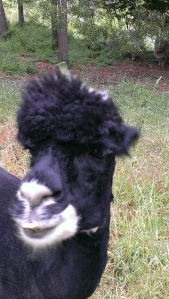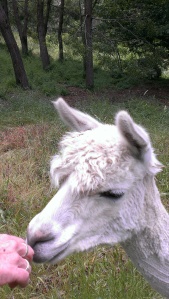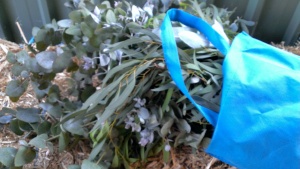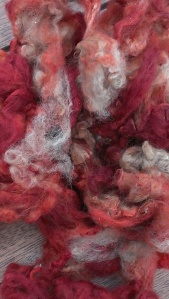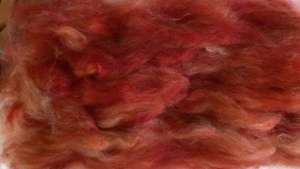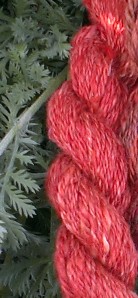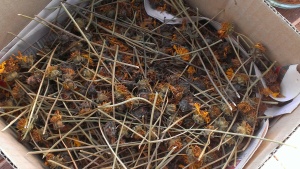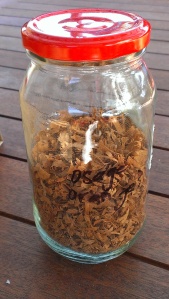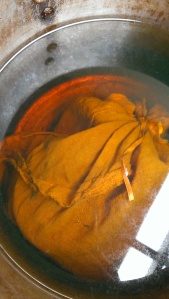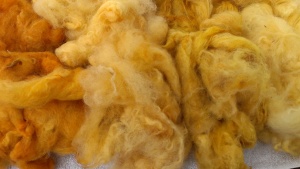A while back, I became the happy recipient of some dyestuffs that had been left at my Guild long ago. Most were labelled, some were not. The only one I had previously tried was indigo. I’m thinking we’ll dye with some of them at natural dyeing workshops I’m running for the guild this year, but I needed to try them out first, check they still have dyeing capacity. There are some in tiny quantities. This one, for instance. 8g of something that looks like a dried fruit or husk, between the size of a hazelnut and a pea. I posted this picture on natural dyeing fora online but got no clues at all. I await any clues readers might be able to offer.

The fact that I can’t identify it is a shame, because here is what happened when my dear friend and I had a dyeing day and tried it out. We soaked it overnight (in rainwater); simmered for an hour, added fibres mordanted in alum and here is the resulting colour. The yarn is mohair mordanted in alum, the sample card (wool and wool+alum) won’t wash off, and the fabric is silk, no mordant. Burgundy… maroon yarns (with pink silk as a background).

We dyed with Osage Orange, which gave jewel bright yellows on silk especially; and Logwood, which gave strong purples even on the second bath (I plan a third).

The Madder is still soaking; and then there is the Red Sanderswood/Red Sandalwood. Based on reading Jenny Dean‘s informative book Wild Colour, my dependable guide in many such matters, I expected hues of orange to brown. I expected to think ‘why ever import this wood when these colours are readily obtainable from so many local plants’? But nature is a complicated thing. I did not expect this:

The roving is unmordanted merino. Almost no dye took at all. What did take amounts to a smudge of orange. The cloth is cotton mordanted with soy, and it is quite a red-brown. Rust, perhaps. The skeins are alpaca-wool blend and mohair, both mordanted in alum. They are vivid purple, and so is the wool mordanted in alum on the sample card. I could scarcely tell the sanderswood skeins apart from the logwood dyed skeins once they dried.
Jenny Dean offers no suggestion of purple from this plant using any combination of mordants. It can’t be a simple case of mislabelling–the logwood baths have produced purple on silk and cotton as well as wool. The sample card was mordanted months ago, using different wool and different alum than these skeins, and any contaminants in my dyepots would have been different, surely. Even my rainwater will have changed in that time. What can it mean? My friend and I decided it meant ‘dye more protein fibres mordanted in alum’, because we both think purple is an exciting outcome!
More natural dyeing mystery–meaning the depths of my ignorance are still being plumbed by this process. But since the result was purple… I mean, purple… I’m not feeling sad about this outcome at all. And the exhaust dyebaths were good fun too. The madder is on its third turn as I write. But more on that later…






























